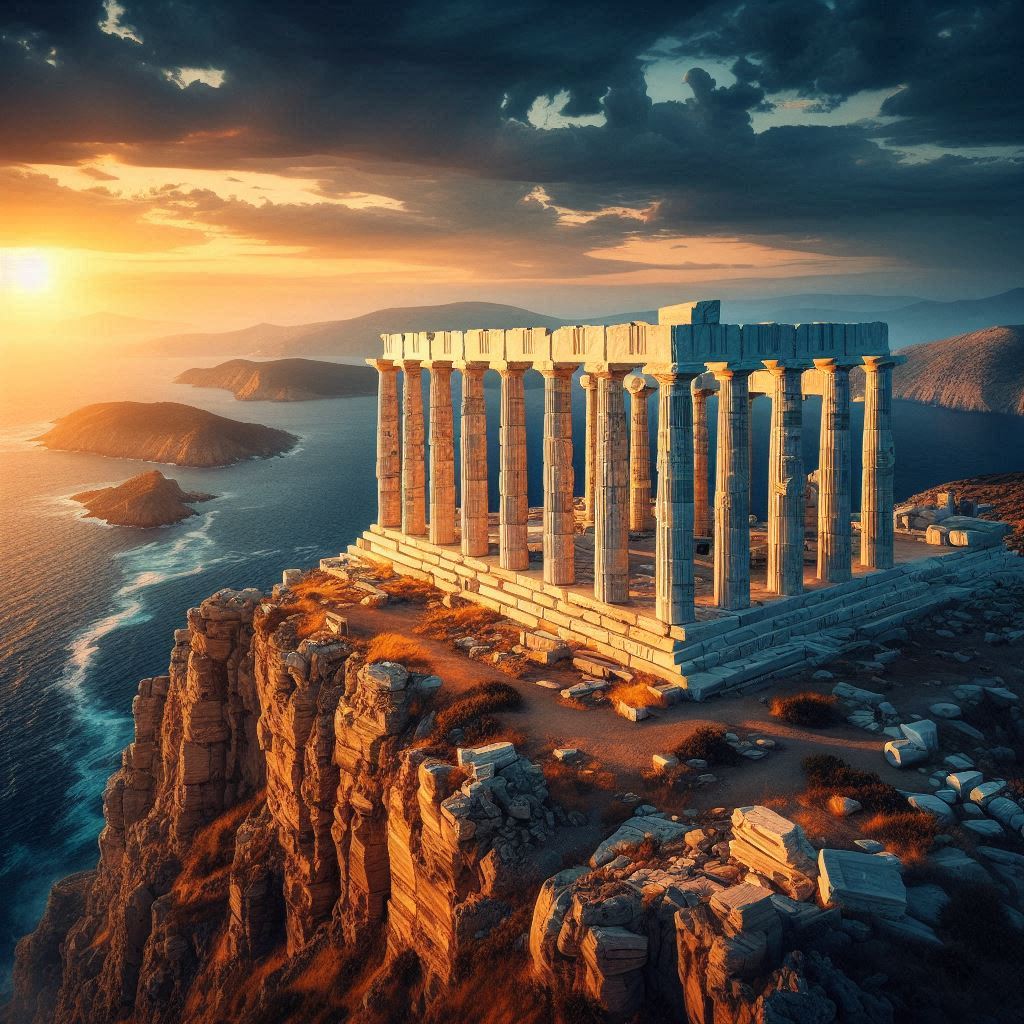Table Of Contents
 God Poseidon , ruler of the seas.
God Poseidon , ruler of the seas.
Introduction
Perched dramatically atop a cliff overlooking the Aegean Sea, the Temple of Poseidon at Cape Sounio stands as one of the most breathtaking monuments of ancient Greece. Built during the Golden Age of Athens in the 5th century BCE, this iconic temple was dedicated to Poseidon, the god of the sea, symbolizing his power and the Athenian people's reverence for the divine. The site, with its sweeping views of the azure waters below, carries a timeless allure, blending history, mythology, and architectural grandeur.
History and Significance
The Temple of Poseidon was constructed between 444–440 BCE during the reign of the Athenian statesman Pericles, who is also credited with overseeing the construction of the Parthenon. Situated at Cape Sounio, the southernmost tip of the Attica Peninsula, the temple was part of a network of sanctuaries that guarded the land of Athens. It replaced an earlier archaic temple that had been destroyed during the Persian Wars around 490 BCE.
 Sounio , god Poseidon's temple.
Sounio , god Poseidon's temple.
The temple’s primary purpose was to honor Poseidon, the mighty ruler of the seas, who held significant sway over the maritime strength of Athens. Sailors and travelers, seeking safe passage across the unpredictable waters of the Aegean, would offer prayers and sacrifices to the god in hopes of favorable conditions. Its strategic location overlooking the sea also made it a crucial point of defense and observation for the Athenians, keeping watch over the vital trade routes and naval passages.
 Construction of the temple.
Construction of the temple.
Architecture of the Temple
The Temple of Poseidon is an exemplary model of Doric architecture, characterized by its simplicity, symmetry, and elegance. Originally, the temple had 34 Doric columns, of which 15 remain standing today. Each column, made of local marble, rises to a height of about 6 meters (20 feet) and boasts a diameter of 1 meter at its base, tapering toward the top in classical Doric style.
The temple followed the traditional rectangular layout, with a pronaos (front porch), cella (inner chamber where Poseidon's statue was housed), and an opisthodomos (rear porch). The inner sanctum would have housed a large bronze statue of Poseidon, now lost to history.
What makes this structure unique is its position at the edge of a cliff, with the Aegean Sea stretching out below. This dramatic setting amplifies the temple’s sense of grandeur and connects it spiritually and visually to Poseidon’s domain — the vast, untamable sea.
 Poseidon , Zeus & Hades
Poseidon , Zeus & Hades
Mythological Connections
The temple’s dedication to Poseidon, the Greek god of the sea, is steeped in mythological lore. Poseidon, brother to Zeus and Hades, held dominion over the waters, storms, and earthquakes. He was often depicted with a trident, which he used to stir the oceans and bring about tempests or calm the waves. His connection to Athens is particularly significant, as he once vied with Athena for control over the city.
According to myth, Poseidon struck the ground with his trident, creating a saltwater spring to impress the Athenians, but Athena's gift of the olive tree won the favor of the people, making her the city’s patron. However, Poseidon’s influence remained strong among the seafaring Athenians, who relied on his favor for their naval dominance.
The Strategic Location of Cape Sounio
Cape Sounio is not only famous for its ancient ruins but also for its strategic importance. As the southernmost point of Attica, it served as a lookout for ships entering and leaving the Aegean Sea. The temple acted as a symbol of Athens' naval supremacy and a place where travelers and sailors could pay homage to Poseidon before embarking on dangerous journeys.
The panoramic views from the temple site extend over the Saronic Gulf and the Cyclades islands. Ancient mariners would have seen the shining marble of the temple from afar, guiding them back toward Athens. The site’s significance as both a religious and military outpost cannot be overstated.
Modern Cultural Impact and Tourism
Today, the Temple of Poseidon at Sounio is one of Greece’s most visited archaeological sites, drawing tourists from all over the world. Visitors flock to witness its majestic beauty, particularly during sunset when the temple is bathed in golden light, creating a dramatic contrast with the blue sea below.
The temple continues to inspire artists, writers, and poets. Lord Byron, the famed British poet, visited the temple in the early 19th century and was so moved by its grandeur that he etched his name into one of the columns (a controversial act by today's standards, but it further cemented the site’s cultural impact).
The site has also become a symbol of romanticism, with its dramatic cliffside setting and stunning views. Cape Sounio offers a peaceful escape from the bustling streets of Athens, only a short drive away, making it a favorite spot for day trips.

Conclusion
The Temple of Poseidon at Sounio is not just an architectural marvel; it’s a testament to the power of myth, nature, and human ingenuity. Its connection to Poseidon, its stunning location, and its historical importance make it a symbol of ancient Greece's maritime prowess and reverence for the gods. As a blend of art, architecture, and mythology, the temple continues to captivate visitors today, standing as a timeless guardian of the Aegean Sea.

